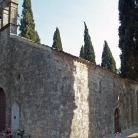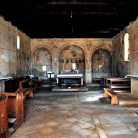The church of St Vincent
Although Svetvinčenat is situated very close to Pula, in the medieval times it was under the Poreč Diocese. The Church of St. Vincent is situated on the cemetery in Svetvinčenat and it’s the only surviving part of the Benedictine monastery, which closed in 1314. Famous Pope Alexander III confirmed the church of St Vincent cum cappelis suis to the Bishop of Poreč in 1178. Svetvinčenat, and more precisely the parish priest of the St Vincent abbey, are also mentioned in the most famous Istrian document “The Istrian Book of Boundaries”. This proves that the medieval town developed around the monastery. From 1209, when it became property of the Istrian Margraviate, Svetvinčenat changed owners various times, until finally in 1523 it became property of the Venetian family Morosini. Under their rule the town developed into Svetvinčenat that we know today, with one of the most beautiful and harmonious Renaissance squares.
The church is unique in its architectural division of a one-nave space with three incorporated apses. The interior is covered with frescoes depicting biblical scenes (The Sacrifice of Abel, Annunciation, Visitation, Crucifixion...), scenes from the life of St Vincent and other saints, as well as an illustrated calendar with a monthly distribution of works. The frescoes are the most extensive Istrian series of Romanesque frescoes, strongly influenced by Byzantine style, painted at the end of the 13th century by master Ognobenus from Treviso. There is an older layer of frescoes, which hasn't been well preserved, as well as a younger layer painted in Italian style, dating from the second half of the 14th and the first half of the 15th century. There are two restored paintings of the apostles and a fragmented altar painting on the north wall portraying the saint and the donor date from this period.
In the church there is also an old wooden statue of Our Lady of Mount Carmel, which used to be carried in processions. Unfortunately, humidity has permeated the frescoes, making them very hard to read. On the other hand, their condition might be responsible for their fascinating old patina and an almost mystical feel.
On the 40th anniversary of blessed Miroslav Bulešić’s death, on August 24, 1987, the priests from Poreč and Pula Diocese set up memorial stone on his grave in front of the church. After a martyr’s death in 1947, Miroslav Bulešić was buried in Lanišće. It wasn’t until 1958 that his remains were transferred to this place, where they stayed until 2003 when they were moved to the parish church.














